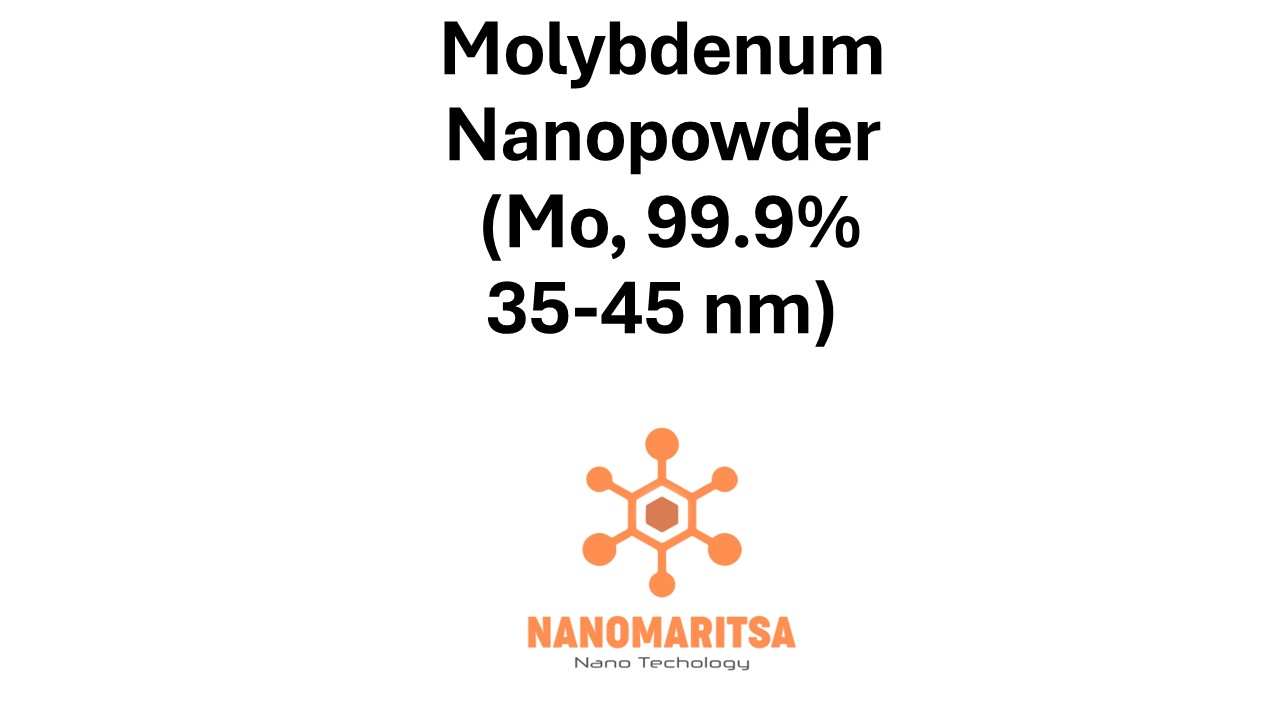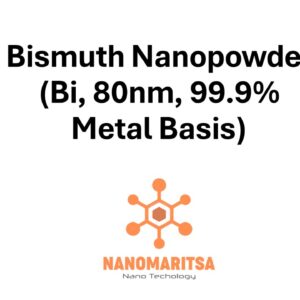Molybdenum Nanopowder (Mo, 99.9%, 35-45 nm) is a high-purity material composed of molybdenum (Mo) nanoparticles in the size range of 35 to 45 nanometers (nm). With a purity of 99.9%, this nanopowder offers excellent material consistency and minimal impurities, making it suitable for a wide range of high-performance applications. The unique properties of molybdenum, coupled with its nanoparticle size, provide significant advantages in various industrial, scientific, and technological fields. Below is a detailed overview of its key features, properties, and applications.
Key Features:
Molybdenum (Mo):
Molybdenum is a refractory metal known for its high melting point, strength, and resistance to corrosion. In nanopowder form, molybdenum offers enhanced surface area, reactivity, and thermal stability, making it an ideal material for advanced applications where these properties are required.
Purity (99.9%):
With a purity level of 99.9%, this molybdenum nanopowder has minimal impurities, ensuring consistent performance in applications where high material quality is critical. The high purity ensures that the powder meets the stringent requirements of various industries.
Particle Size (35-45 nm):
The particle size of 35-45 nm is ideal for applications requiring high surface area and reactivity. This size range strikes a balance between maintaining the unique properties of molybdenum while offering sufficient surface area for interactions in chemical, catalytic, and mechanical applications.
Properties:
High Melting Point:
Molybdenum has a high melting point (~2,623°C), which makes it highly suitable for high-temperature applications. The nanopowder form retains this characteristic, making it useful in environments where elevated temperatures are prevalent, such as in aerospace or energy sectors.
Thermal Stability:
Molybdenum nanopowder exhibits excellent thermal stability, which ensures that it maintains its structural integrity even under extreme conditions. This property is critical for applications in high-temperature environments, such as in manufacturing processes and materials used in aerospace and electronics.
High Strength and Toughness:
Molybdenum is known for its exceptional strength and toughness, even at high temperatures. The nanopowder form preserves these mechanical properties, making it suitable for use in materials that require durability and resistance to wear.
Chemical Resistance:
Molybdenum exhibits resistance to corrosion and oxidation, particularly at elevated temperatures. This makes the nanopowder suitable for applications in harsh chemical environments, such as in chemical processing, industrial manufacturing, and corrosion-resistant coatings.
High Surface Area:
With its nanoscale size, molybdenum nanopowder offers a significantly increased surface area compared to bulk molybdenum. This high surface area enhances the material’s reactivity and catalytic properties, making it highly effective in chemical reactions and as a catalyst.
Electrical Conductivity:
Molybdenum nanopowder retains the excellent electrical conductivity properties of its bulk form, making it useful in applications requiring conductive materials, such as in electronics and electrical components.
Applications:
- Aerospace and Defense:
Molybdenum’s high melting point, strength, and resistance to high temperatures make it ideal for use in aerospace components, such as turbine blades, rocket nozzles, and heat shields. The nanopowder can also be used in lightweight, high-strength composite materials. - Electronics and Electrical Components:
Due to its excellent electrical conductivity, molybdenum nanopowder is used in various electronic and electrical applications, such as in the manufacturing of semiconductors, capacitors, and other components that require precise electrical performance. - Catalysis and Chemical Reactions:
Molybdenum is used as a catalyst in various chemical reactions, such as in the production of hydrogen, petroleum refining, and the synthesis of chemicals. The high surface area of the nanopowder enhances its catalytic efficiency, making it a key component in industrial catalytic processes. - Energy Storage Systems:
Molybdenum nanopowder is being explored for use in energy storage technologies such as batteries and supercapacitors. Its high surface area and good electrical conductivity make it an ideal material for improving the performance and lifespan of energy storage devices. - Metal Alloys:
Molybdenum nanopowder is often used as an alloying element in the production of steel and other metals to improve properties such as strength, hardness, and resistance to corrosion and heat. It is particularly valuable in high-performance alloy systems used in heavy machinery, automotive, and industrial applications. - Corrosion-Resistant Coatings:
Molybdenum’s resistance to corrosion and oxidation makes it an ideal candidate for coatings that protect metal surfaces in aggressive environments, such as marine, petrochemical, and industrial applications. - High-Temperature Materials:
Molybdenum nanopowder is commonly used in the production of materials designed for high-temperature environments. This includes components such as furnace linings, heat exchangers, and components for the nuclear and aerospace industries. - Biomedical Applications:
Molybdenum nanopowder may also be used in certain biomedical applications, such as in diagnostic imaging, drug delivery, and biomedical sensors. Its biocompatibility and ability to interact with biological systems make it useful in targeted therapy and diagnostic techniques. - Environmental Applications:
Molybdenum nanopowder is being studied for use in environmental applications such as water purification and the removal of heavy metals from wastewater. Its high surface area and chemical reactivity make it effective for adsorbing contaminants and toxins from the environment.
Handling and Safety:
Health and Safety Considerations:
Molybdenum nanopowder should be handled with care to avoid inhalation, ingestion, or skin contact. Personal protective equipment (PPE), such as gloves, masks, and safety goggles, should be used when working with the material. Work in a well-ventilated area to minimize the risk of inhaling fine dust particles.
Storage:
Store molybdenum nanopowder in a cool, dry, and well-ventilated environment to prevent oxidation or contamination. The container should be tightly sealed to prevent exposure to air and moisture, which could degrade the material’s properties.
Precautions:
Avoid generating dust or aerosols during handling. When working with molybdenum nanopowder, it is important to take steps to minimize airborne particles. Dispose of any waste material according to local environmental regulations to prevent contamination.
Summary:
Molybdenum Nanopowder (Mo, 99.9%, 35-45 nm) is a high-purity, nanoscale material that combines the unique properties of molybdenum with the advantages of increased surface area and reactivity. The 35-45 nm particle size enhances the material’s catalytic, chemical, and electrical properties, making it suitable for a wide range of applications, including aerospace, energy storage, catalysis, and electronics. Molybdenum’s high melting point, corrosion resistance, and strength make it an invaluable material in high-performance industries. Proper handling, storage, and safety precautions are essential to maintain its effectiveness and ensure safe use in advanced technologies.
| Measurement (gr) | 100 grams, 500 grams, 1000 grams |
|---|






